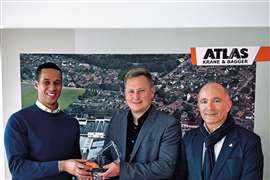Size matters: why roadbuilders are shrinking with growing urbanisation
02 February 2022
As urbanisation grows, so roadbuilding equipment shrinks, with the popularity of compact machines capable of operating in built-up areas booming. Mike Hayes reports
More than 70% of people in Europe are now living in cities, with rapid growth set to continue in the coming years.
Seeing conurbations as being at the forefront of innovation, productivity and economic growth, the European Union is keen to ensure spaces within them are as ergonomic, attractive and liveable as possible.
With this in mind, many urban spaces are being redesigned, with roads at the heart of major cities being transformed into sprawling pedestrian areas, and some central and arterial roads being taken underground.
In the European Commission’s 10-year strategy from 2020, it states, “Healthy, compact and energy-efficient cities are key to green growth in Europe. Many European cities are currently developing or expanding their networks for sustainable transport, waste management, district heating and green infrastructures.”
 Dynapac has developed techniques to protect the sensitive components of its CC900 e roller from the effects of vibration.
Dynapac has developed techniques to protect the sensitive components of its CC900 e roller from the effects of vibration.
All this means a steady stream of progressive projects coming through for contractors operating in European cities. That said, inner-city construction projects have always come with specific challenges and they are only set to become more restrictive.
As the authorities driving these projects have strict reporting rules, contracts will tend to be won by the lowest bidder. This can make bidding on a project extremely difficult, given the numerous opportunities for disruptions, as well as the challenges of space limitations and logistical complexities.
Selecting the right equipment is also key and can make the difference between a successful outcome and simply a drain on resources and the bottom line.
European low emission zones
One of the biggest concerns for projects taking place in busy cities and urban areas is that of emissions and, certainly in European cities, low emission zones (LEZs) are rolling out at a tremendous pace.
The introduction of electric equipment is one obvious answer for contractors; these machines tend to have no local emissions and come with the additional benefit of low noise pollution, meaning work can often progress beyond ‘sociable’ hours.
A decade ago – long before it became a generally accepted option for construction equipment – compaction specialist Dynapac developed an electric roller prototype.
Ahead of its time, Dynapac was forced to put the development on the back burner but is now weighing in with its CC900 e electric roller.
The machine has been developed to deliver the same linear load, amplitude, frequency, and travel speed as the diesel-powered model upon which it is based, but, even with its years of experience, Dynapac admits perfecting the machine was not without its challenges.
The company’s compaction application specialist Fredrik Åkesson says, “Vibration is a known enemy of finely-tuned electronics. A machine like a mini excavator or a skid steer loader will experience a degree of vibration. But on a tandem roller like the CC900 e, vibration is its very purpose.
“We use electro-hydraulics to deliver the vibratory motion required to compact the material. This allows us to isolate most of the vibration from the electric motors.”
At the same time, there are benefits to using electric equipment that perhaps go beyond the obvious. Åkesson says, “Even though a double-drum vibratory roller in this class does a full working day, that doesn’t mean it is continually compacting. This type of roller is often left idling while asphalt is raked into position. The machine may then travel on to the next pothole repair where it may stand idle again. On a diesel-fuelled machine, that is wasted energy, wasted money and it carries a significant environmental impact.”
Wacker Neuson construction equipment
Another company that is no stranger to electric equipment is Wacker Neuson, which first put its battery-powered construction equipment on the market in 2015, and has steadily built its portfolio to include compaction equipment such as vibration plates as well as excavators, dumpers and wheeled loaders.
The company says reductions of up to 93% in CO2 emissions can be made through the use of these electric machines, compared with a conventional model of the same class.
 Batteries on the charge… a Wacker Neuson DW15e dumper operates in a town centre with the new EZ17e excavator.
Batteries on the charge… a Wacker Neuson DW15e dumper operates in a town centre with the new EZ17e excavator.
Impressive noise reductions of around 20 decibels also mean inner-city night construction can be undertaken.
Most recently Wacker Neuson introduced its zero tail-swing excavator EZ17e. with an integrated lithium-ion battery, the machine can operate plugged or unplugged, charging at power sources from 100 to 415 volts.
The company says the excavator can operate unplugged for an entire working day, with no loss of performance, compared with a diesel-powered equivalent machine.
For compaction work in sensitive environments, Wacker Neuson offers three battery-powered vibratory rammers and six vibratory plates.
The basis for all models is a lithium-ion rechargeable battery, designed to be rugged. The modular battery can be used on all compaction machines and can simply be swapped between them.
As well as the motor being maintenance-free, all typical maintenance requirements on conventional vibratory rammers, such as on the carburettor, do not occur with the battery-powered rammer.
Alexander Greschner, sales director of the Wacker Neuson Group, is in no doubt that electrification of equipment is the way forward, when it comes to urban environments. He says, “We can offer our customers an electric alternative for a variety of applications, meaning that the emission-free construction site in the inner city is today already a reality. We took this step as one of the first in the industry, and the increasing demand confirms that we should pursue this further and expand the range.”
Do all European countries have low emission zones?
It should be said that not all European countries are ready to roll out low emission zones. Furthermore, few contractors are in a position to sell off perfectly good diesel machines and pay hefty upfront costs to replace them with electric models.
Moreover, modern diesel engines run extremely clean, and even engine manufacturers working hard to develop alternative power are quick to admit that diesel still has a healthy future.
Earlier this year, Bobcat confirmed the rollout of its new Next is Now light compaction range for soil and asphalt, launched in collaboration with Swiss mechanical engineering company Ammann.
 Bobcat has moved into the light Compaction segment for the first time, in collaboration with the Ammann Group.
Bobcat has moved into the light Compaction segment for the first time, in collaboration with the Ammann Group.
The Next is Now range – a new entry into the compaction product category for Bobcat – will ultimately comprise 37 models, from vibratory rammers weighing 29kg, up to 2.6 tonne tandem rollers.
The company has launched vibratory rammers and plates, as well as hydrostatic plates, designed for heavier compaction work in civil engineering and road construction.
The rammers line-up comprises six models – the R30, R60, R68, R60P, R68P and R70D – ranging from 29kg to 89kg, and useful for road maintenance due to their compactness and ease of transport.
Bobcat’s new walk-behind rollers are primarily designed to compact bituminous material. The WR65 model, available in two versions with a choice between Hatz or Yanmar engines, is equipped with dual drums for maximum compaction.
Cat construction equipment upgrades
Cat recently upgraded its compaction offering with the introduction of three new tandem and combination utility compactors, promising increased productivity, combined with simple operation and easy maintenance.
The CB2.5 GC, CB2.7 GC and CC2.7 GC rollers, all in the 2 to 3 tonne class, are designed for applications including car parks, urban streets and small construction sites and each is powered by an engine that meets Stage V emission standards without the need for aftertreatment, lowering service costs.
Advanced hydraulics and exclusive power management software help deliver equivalent performance with the smaller engine. Their new auto idle shutdown feature helps to conserve fuel and machine hours.
Cat says operator controls feature simple rocker switches and what an easy-to-read display.
 Cat’s new stage V-compliant CB2.7GC tandem roller promises optimum uptime and simplicity of use for operators.
Cat’s new stage V-compliant CB2.7GC tandem roller promises optimum uptime and simplicity of use for operators.
Compaction widths range from 1,000mm to 1,300mm, with drum diameters of 720mm and 14mm drum shells adding to the compactive effort.
A simple rocker switch controls vibration frequencies, with an auto vibration control, which ceases vibration when the travel lever is in neutral.
Another upgrade feature of the GC range is a water tank gauge and improved nozzles on the spray bars, which improve water coverage on the drum to prevent material pick-up.
Standard on-board technology includes ProductLink, which captures operating data to boost fleet management efficiency. An optional extra is Remote Troubleshoot, which analyses real-time machine data, potentially avoiding service trips to site and unnecessary downtime.




